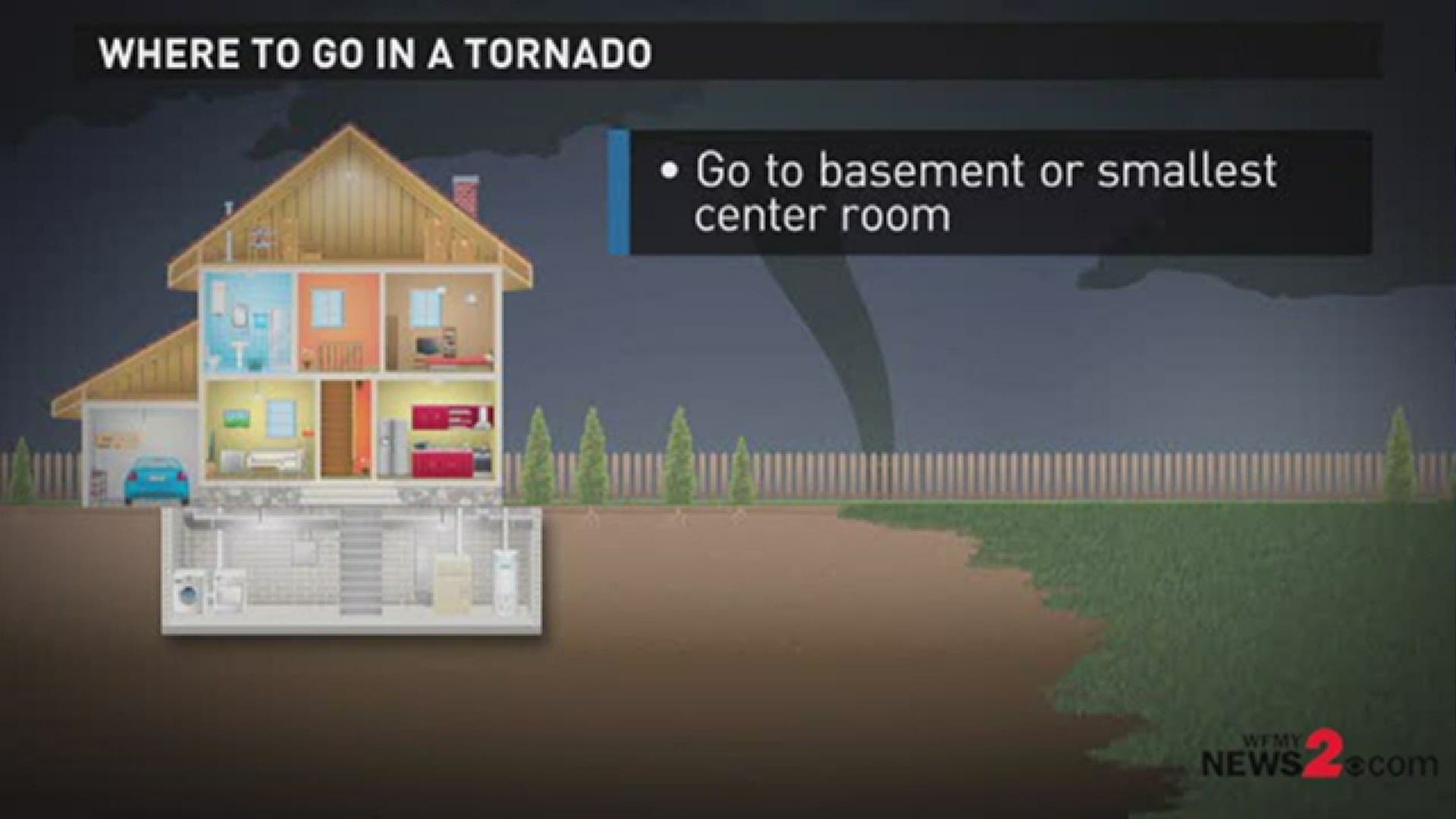GREENSBORO, N.C. — Tornadoes are spawned from strong, severe thunderstorms and not only cause devastation but can kill those in the pathway of destruction. North Carolina averages about 28 tornadoes per year.
A tornado appears as a rotating, funnel-shaped cloud that extends from a thunderstorm to the ground with whirling winds that can reach 300 miles per hour, in the strongest ones. Some tornadoes are clearly visible, while rain or nearby low-hanging clouds can obscure others. In some instances, tornadoes can develop so rapidly that little, if any, advance warning is possible, making them even more dangerous.
It's important to have a plan and to know where to seek shelter in the event of a tornado.
Here are some safety tips, that could keep you and your family safe during a tornado.
BEFORE A TORNADO
- Be alert to changing weather conditions.
- Listen to NOAA Weather Radio or to commercial radio or television newscasts for the latest information.
- Look for approaching storms.
LOOK FOR DANGER SIGNS
- Dark, often greenish sky
- Large hail
- A large, dark, low-lying cloud (particularly if rotating)
- Loud roar, similar to a freight train
- If you see approaching storms or any of the danger signs, be prepared to take shelter immediately.
DURING A TORNADO
- If you are under a tornado warning, seek shelter immediately.
- Get indoors to a pre-designated shelter area such as a basement, storm cellar or the lowest building level. If there is no basement, go to the center of an interior room on the lowest level (closet, interior hallway) away from corners, windows, doors, and outside walls.
- Shutter windows and outside doors.
- If in a vehicle, trailer, or mobile home, get out immediately and go to the lowest floor of a sturdy, nearby building or storm shelter.
- If unable to get indoors, lie flat in a nearby ditch or depression and cover your head with your hands. Be aware of potential flooding and flying debris.
- Never try to outrun a tornado in your vehicle. Instead, leave the vehicle immediately for safe shelter.
HOME SAFETY
In homes or public buildings go to the basement or a small interior room such as a closet, bathroom or an interior hall on the lowest level. Close all doors to the hallway for greater protection. If possible, get under something sturdy like a heavy table. Protect yourself from flying debris with pillows, heavy coats, blankets, or quilts. Use bicycle or motorcycle helmets to protect your head.
MOBILE HOME
If you're inside a mobile home, leave well in advance of the approaching severe weather and go to a strong building. If there is no shelter nearby, get into the nearest ditch, low spot or underground culvert. Lay flat, covering your head with your hands for protection.
VEHICLE
If you're in a vehicle or outdoors when tornadoes are possible, limit your outdoor plans or finish them early. If your vehicle is hit by flying debris while you are driving, pull over and park, and cover your head with your arms and a blanket, coat, or another cushion if possible. Lie in an area noticeably lower than the level of the roadway and cover your head with your arms and a blanket, coat, or another cushion if possible. Do not get under an overpass or bridge. You are safer in a low, flat location. Never try to outrun a tornado in urban or congested areas in a car or truck. Instead, leave the vehicle immediately for safe shelter.
OUTSIDE
Stay close to a sturdy shelter. If caught outside, find shelter in a ditch or remain in your vehicle and cover your head for protection. Do not take shelter under a highway overpass, where wind speeds can increase due to a tunneling effect. It is best not to put yourself or others in a situation where no sturdy shelter is available.
If you are in a structure such as a residence, small building, school, nursing home, hospital, factory, shopping center, or high-rise building:
- Go to a pre-designated area such as a safe room, basement, storm cellar, or the lowest building level. If there is no basement, go to the center of a small interior room on the lowest level (such as a closet, bathroom, or interior hallway) away from corners, windows, doors, and outside walls. Put as many walls as possible between you and the outside. Get under a sturdy table and use your arms to protect your head and neck.
- In a high-rise building, go to a small interior room or hallway on the lowest floor possible.
- Do not open windows.
If you are in a manufactured home or office:
- Get out immediately and go to a pre-identified location such as the lowest floor of a sturdy nearby building or a storm shelter. Mobile homes, even if tied down, offer little protection from tornadoes.
- If you are outside with no shelter available, there is no single research-based recommendation for what last-resort action to take, because many factors can affect your decision.

